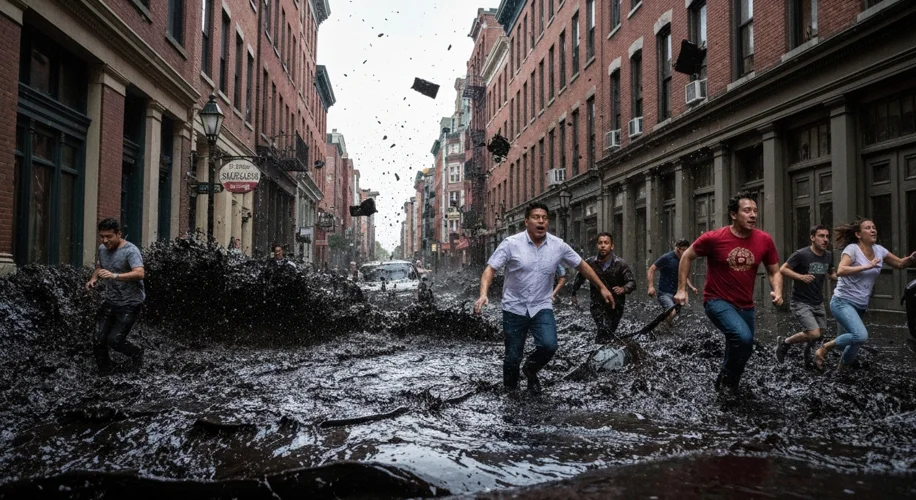In the heart of Boston, on a sweltering January day in 1919, a disaster of unimaginable viscosity unfolded. It wasn’t a fire, nor a bomb, but something far stranger and more insidious: a tsunami of molasses.

It was a crisp winter afternoon, January 15, 1919, and Boston was abuzz. The Great War had recently ended, and a sense of normalcy, however fragile, was returning. But beneath the veneer of post-war optimism, a ticking time bomb, or rather, a seeping tank, was about to explode. The Purity Distilling Company, a subsidiary of United States Industrial Alcohol, operated a colossal storage tank on the North End waterfront. This behemoth, standing 50 feet tall and 40 feet in diameter, held an astounding 2.3 million gallons of thick, dark molasses – enough to fill a small lake. This molasses wasn’t destined for consumption; it was to be fermented into industrial alcohol, a crucial component in munitions manufacturing during the war and now slated for commercial use.
The tank, however, had a dark secret. It was poorly constructed and notoriously leaky. Residents of the North End, a densely populated Italian immigrant neighborhood, often complained about the sticky brown goo that oozed from its seams, coating their streets, buildings, and even their clothes. Children would collect the dripping molasses, and horses would often get stuck in the sweet, viscous puddles. The company, notoriously indifferent to these pleas, had even painted the tank brown to hide the leaks. Whispers among workers spoke of ominous groaning sounds emanating from the structure, a sound that should have been a deafening alarm.
Around 12:30 PM, the unthinkable happened. A deafening roar ripped through the North End. The massive tank, unable to withstand the immense pressure of its sweet, dark cargo, ruptured. Witnesses described a sound like machine-gun fire as the rivets popped, followed by an explosion that shook the very foundations of the city. A colossal wave, estimated to be 15 to 25 feet high and moving at a speed of 35 miles per hour, surged through the streets. It was a tidal wave of molasses, dark, sticky, and deadly.
The sheer force of the wave was devastating. Buildings were crushed, their structures ripped apart by the viscous onslaught. Wagons were tossed aside like toys, and horses and people were engulfed. The dense molasses, moving with terrifying speed, acted like a liquid battering ram, suffocating and crushing everything in its path. The air was thick with the cloying, sweet smell of molasses, a smell that would forever be etched into the memories of survivors.
Rescue efforts were immediate but agonizingly slow. The molasses, even in death, was a formidable adversary. It coated everything, making movement treacherous. Rescuers waded through waist-deep goo, their boots sucked down by the sticky mass. Many who had survived the initial wave were trapped, slowly succumbing to the suffocating sweetness. The sheer volume of molasses made it incredibly difficult to search for survivors, and the cold January air offered little relief from its suffocating embrace.
The aftermath was grim. Twenty-one people lost their lives, and over 150 were injured. The North End was a scene of utter devastation, transformed into a sticky, brown wasteland. The clean-up operation took weeks, involving hundreds of workers, firefighters, and even the U.S. Navy, who were called in to help wash down the streets with powerful water hoses.

The disaster, however, was not without its lasting impact. It led to one of the first major class-action lawsuits in Massachusetts. The Purity Distilling Company, and its parent company, United States Industrial Alcohol, were held liable for negligence. The court’s decision, which took over three years to reach, established a crucial precedent: companies could be held responsible for the consequences of their negligence, even in the absence of specific safety regulations.
The Great Molasses Flood became a cautionary tale, a stark reminder of the dangers of unchecked industrial ambition and the importance of corporate accountability. It’s a bizarre, sticky, and ultimately tragic chapter in Boston’s history, a day when a sweet treat turned into a deadly disaster, forever leaving its mark on the city’s memory.

Even today, locals claim that on hot summer days, the sweet scent of molasses still permeates the North End, a ghostly reminder of the day Boston drowned in a river of syrup. It’s a story that sticks with you, a testament to the day a sweet disaster became a bitter lesson.

